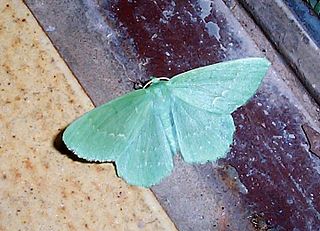
The large emerald is a moth which is the type species for the family Geometridae. It is found throughout the Palearctic region and the Near East in and around deciduous forests, heathlands, marshland and in settlements close to woodland. The species was first described by Carl Linnaeus in his 1758 10th edition of Systema Naturae.
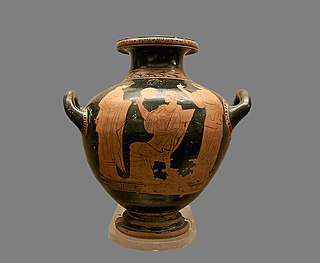
The hydria is a form of Greek pottery from between the late Geometric period and the Hellenistic period. The etymology of the word hydria was first noted when it was stamped on a hydria itself, its direct translation meaning 'jug'.
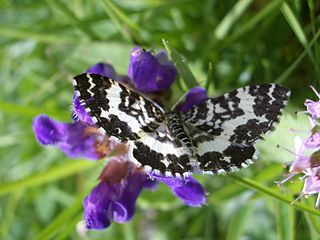
The argent and sable moth is a day-flying moth of the family Geometridae, with distinctive black and white colors. They tend to live on wetlands and hillsides. The larvae spin together the leaves of their food plants to form their cocoons. It was named argent and sable in 1778. Argent and sable refer to the heraldic color names for white and black. Their distribution is Holarctic. The species was first described by Carl Linnaeus in his 1758 10th edition of Systema Naturae.

The scarce copper is a butterfly of the family Lycaenidae.
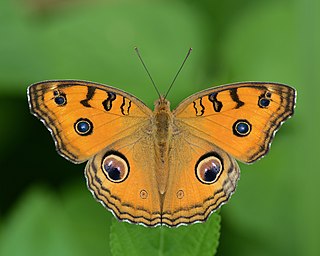
Junonia almana, the peacock pansy, is a species of nymphalid butterfly found in Cambodia and South Asia. It exists in two distinct adult forms, which differ chiefly in the patterns on the underside of the wings; the dry-season form has few markings, while the wet-season form has additional eyespots and lines. It is listed as Least Concern in the IUCN Red List.

Hippotion celerio, the vine hawk-moth or silver-striped hawk-moth, is a moth of the family Sphingidae. It was described by Carl Linnaeus in his 1758 10th edition of Systema Naturae.

The scarce fritillary is a species of butterfly in the family Nymphalidae. It is found in Austria, Bulgaria, Czech Republic, Finland, France, Germany, Greece, Hungary, Kazakhstan, Lithuania, Luxembourg, Poland, Romania, Russia, Serbia and Montenegro, and Sweden. and East across the Palearctic to Mongolia.

Idaea dimidiata, the single-dotted wave, is a moth of the family Geometridae. It is a Holarctic species.
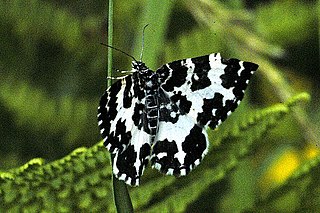
Rheumaptera is a genus of moths of the family Geometridae erected by Jacob Hübner in 1822.

Cyclophora annularia, the mocha, is a moth of the family Geometridae. The species was first described by Johan Christian Fabricius in 1775 and it can be found in Europe.

Colias erate, commonly known as the eastern pale clouded yellow, is a species of butterfly in the family Pieridae. It is found from south-eastern Europe, through Turkey over central Asia up to Japan and Taiwan. To the south, its range stretches to Somalia and Ethiopia. The species was first described by Eugenius Johann Christoph Esper in 1805.

Apamea lateritia, the scarce brindle, is a moth of the family Noctuidae. It is found in much of the Palearctic. It is a sporadic migrant in Great Britain, where it is recorded from the east and south-east coasts.

Rheumaptera subhastata, the white-banded black moth, is a moth of the family Geometridae. It is found in the Palearctic and Nearctic realms, where it is widely distributed in western North America.

Rheumaptera undulata, the scallop shell, is a moth of the family Geometridae. It was first described by Carl Linnaeus in his 1758 10th edition of Systema Naturae. It is found in most of the Palearctic realm and North America.
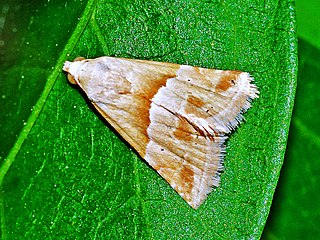
Eublemma parva, the small marbled, is a moth of the family Erebidae. The species was first described by Jacob Hübner in 1808.

Carpatolechia notatella, the sallow-leaf groundling, is a moth of the family Gelechiidae. It is found in most of Europe and Turkey.

Tingena letharga is a species of moth in the family Oecophoridae. It is endemic to New Zealand and has been observed in Otago. Adults are on the wing in December and January.

Opsitycha squalidella is a moth of the family Oecophoridae. It was described by Edward Meyrick in 1884. This species is native to Australia and is likely adventive to New Zealand.
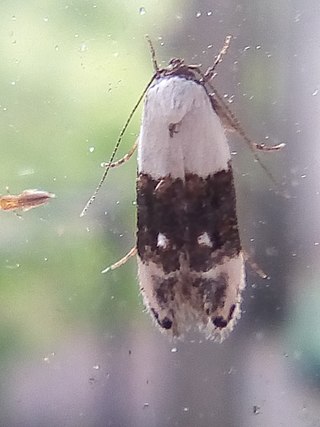
Trachypepla amphileuca is a species of moth in the family Oecophoridae. It is endemic to New Zealand and has been observed in the North Island. This species inhabits native forest. Adults are on the wing from October to January and are attracted to light. The wing pattern of T. amphileuca is said to imitate the appearance of bird droppings.




















